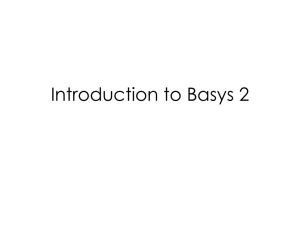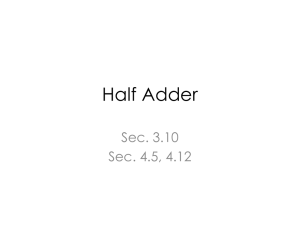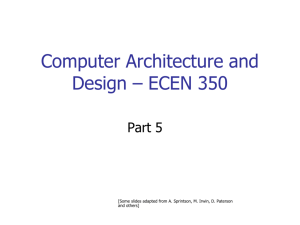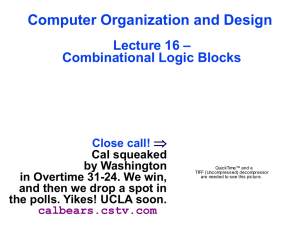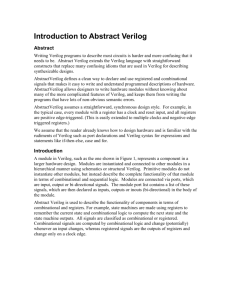Week 3
advertisement
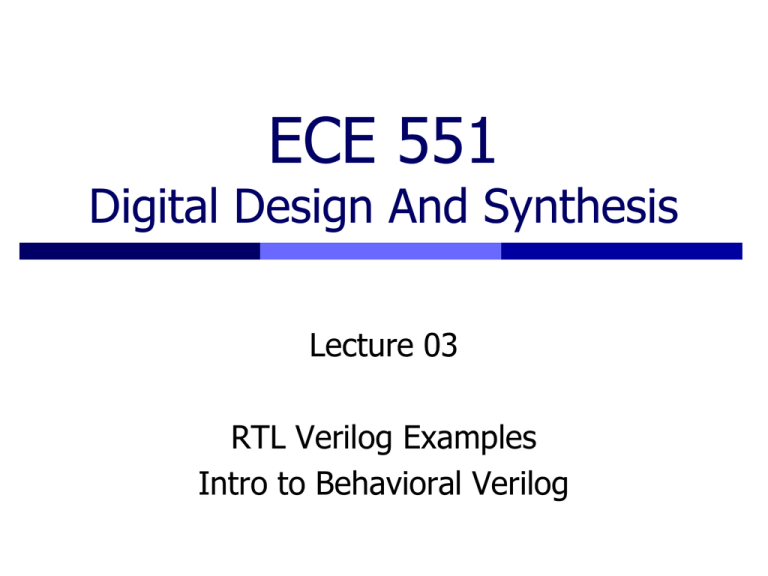
ECE 551
Digital Design And Synthesis
Lecture 03
RTL Verilog Examples
Intro to Behavioral Verilog
Topics
RTL Verilog Examples
Commenting in Verilog
Introduction to Behavioral Verilog
Blocks and Triggers
Procedural Assignments
Edge Triggering
2
RTL Example – Dual Mux
module mux2_32b (mux_out_1, mux_out_2, data_1, data_0, select);
output [31: 0] mux_out_1, mux_out_2;
input [31: 0] data_1, data_0;
input select;
assign mux_out_1 = select ? data_1 : data_0;
assign mux_out_2 = select ? data_0 : data_1;
endmodule
Can you describe what this module does?
Does the ordering of the assignments matter?
3
Example: Priority Encoder
module prienc_4to2( output [1:0] out, input in0, in1, in2, in3);
endmodule
Use the conditional operator and a single continuous assignment statement
Give in3 highest priority.
4
Implicit Continuous Assignments
Can create an implicit continuous assign
Goes in the wire declaration
wire [3:0] sum = a + b;
Can be a useful shortcut to make code succinct,
but doesn’t allow fancy LHS combos
assign {cout, sum} = a + b + cin;
Personal choice
You are welcome to use it when appropriate
5
Implicit Net Declarations
When wire is used but not declared, it is implied
module majority(output out, input a, b, c);
assign part1 = a & b;
assign part2 = a & c;
assign part3 = b & c;
assign out = part1 | part2 | part3;
endmodule
Implicit declaration is risky
Makes code difficult to follow (how many bits?)
Breaks compatibility with some documentation tools
Disable by using `default_nettype none directive
Helps to avoid wasting time on typos
You will need to explicitly declare input/output types!
Don’t use them in Homework
6
Latches
Continuous assignments with feedback
module latch(output q_out, input data_in, enable);
assign q_out = enable ? data_in : q_out;
endmodule
module latch_reset(output q_out, input data_in, enable, reset);
assign q_out = reset ? 0 : (enable ? data_in : q_out);
endmodule
How could we change these to be 8-bit latches?
How could we make the enable active low?
Does enable or reset have higher priority?
9
Latches
A lot of designers recommend that you avoid using
latches in designs you intend to Synthesize
Why do we avoid Latches?
The presence of latches can cause problems during
the Static Timing Analysis phase of Synthesis
It is more difficult to get the timing behavior of
latches to match simulation because they are
sensitive to glitches
Some design platforms – like many FPGAs – do not
support synthesis of latches.
Use FFs instead of Latches!
10
Example: Rock-Paper-Scissors
module rps(output win, player,
input [1:0] p0guess, p1guess);
Assumptions:
Input: p0guess, p1guess = {0 for rock, 1 for paper, 2
for scissors} – assume 3 will never happen
Output: player is 0 if p0 wins, 1 if p1 wins, and don’t
care if there is a tie
Output: win is 0 if there is a tie and 1 if a player wins
Reminders
Paper covers rock, scissors cut paper, rock smashes
scissors
Is a tie if guesses are the same
11
Example: Rock-Paper-Scissors
Two possible approaches
Figure out Boolean equations for win and player
and implement these using continuous assignments
Use bitwise operators
Examine what the various items equal and do
logical operations on these
Use equality and logical operators
12
Solution 1: Rock-Paper-Scissors
module rps(win, player, p0guess, p1guess);
input [1:0] p0guess, p1guess;
output
win, player;
What steps do we need to find the Boolean representation?
Write a truth table
Create k-maps for each output
Write minterms/maxterms
Simplify Boolean expressions (optional)
endmodule
13
Solution 1: Rock-Paper-Scissors
module rps(win, player, p0guess, p1guess);
input [1:0] p0guess, p1guess;
output
win, player;
assign win = |(p0guess ^ p1guess);
assign player = (p1guess[0] ^ p0guess[1]) |
(p1guess[1] & p0guess[0]);
endmodule
What does this description synthesize to?
14
Solution 2: Rock-Paper-Scissors
module rps(win, player, p0guess, p1guess);
input [1:0] p0guess, p1guess;
output
win, player;
How can we express this in terms of Relational and Equality
operators?
Rock = 2’d0, Paper = 2’d1, Scissors = 2’d2
endmodule
15
Example: FSM Pattern Detector
Recognize the occurrence of the bit pattern 111. The output is to be a
1 when the two previous inputs were 11 and the current input is 1.
Use flip-flops dff_async_pc(input d, output q, input pre, clr, clk);
pre (preset) and clr (clear) are asynchronous flip-flop inputs
Draw a state diagram, then use a one-hot state assignment.
module pattern111 (output y, input x, rst, clk);
wire [2:0] cur;
// current state (flip-flop outputs)
wire [2:0] next; // next state (flip-flop inputs)
//Flip-flop Instantiations
// Input equations
// Output equation
endmodule
16
Example: FSM
Use flip-flops dff_async_pc(input d, output q, input pre, clr, clk);
module pattern111 (output y, input x, rst, clk);
wire [2:0] cur;
// current state (flip-flop outputs)
wire [2:0] next; // next state (flip-flop inputs)
//Flip-flop Instantiations
dff_async_pc
// Input equations
assign next[0] =
assign next[1] =
assign next[2] =
// Output equation
assign y =
endmodule
17
Topics
RTL Verilog Examples
Commenting in Verilog
Introduction to Behavioral Verilog
Blocks and Triggers
Procedural Assignments
Edge Triggering
18
A Brief Comment on Comments
Make your code easier to understand
// this is a comment (to the end of the line)
assign msg = addr & 16’h1FFF; //mask off sender ID
Block comments are also supported, i.e. /* <stuff>
*/
Make them useful!
Give an overview of what the module does
Label major sections of code (e.g., next state logic,
output equations, flip-flops).
Comment the portions of the code that may be unclear
Don’t go overboard: wire [7:0] sum; //an 8-bit sum
Use them where needed in remaining assignments
& project
19
Topics
RTL Verilog Examples
Commenting in Verilog
Introduction to Behavioral Verilog
Blocks and Triggers
Procedural Assignments
Edge Triggering
20
Behavioral Verilog
Instead of describing what the hardware looks like,
describe what you want the hardware to do
Goal: Abstract away the details of the hardware
implementation to make design easier
In reality: Mixed success
The synthesizer creates a hardware structure that
does the same thing as your description
… but the synthesizer has to be able to realize your
description using real hardware constraints
This is why not all Verilog constructs are supported
21
Behavioral Verilog
Use procedural blocks: initial, always
Blocks contain an ordered series of statements
Abstract – works *somewhat* like software
Be careful to still remember it’s hardware if you want to
synthesize!
Parallel operation across blocks
All blocks in all modules operate simultaneously
Sequential or parallel operation within blocks
Depends on the way the block is written
Will discuss this in a later lecture
LHS of assignments must be variables (reg)
Not necessarily “registers”
22
Types of Blocks
initial
Behavioral block operates ONCE
Starts at time 0 (beginning of operation)
Useful for testbenches
Inappropriate for combinational logic
Usually cannot be synthesized
Can sometimes provide initialization of memories/FFs
Depends on the synthesizer
always
Behavioral block operates CONTINUOUSLY
Can use a sensitivity list to control operation; @(a, b, c)
23
initial vs. always
reg [7:0] v1, v2, v3, v4;
reg [7:0] v1, v2, v3, v4;
initial begin
v1 = 1;
#2 v2 = v1 + 1;
v3 = v2 + 1;
#2 v4 = v3 + 1;
v1 = v4 + 1;
#2 v2 = v1 + 1;
v3 = v2 + 1;
end
always begin
v1 = 1;
#2 v2 = v1 + 1;
v3 = v2 + 1;
#2 v4 = v3 + 1;
v1 = v4 + 1;
#2 v2 = v1 + 1;
v3 = v2 + 1;
end
What values does each block produce?
24
initial Blocks
`timescale 1ns /1ns
module t_full_adder;
reg [3:0] stim;
wire s, c;
all initial blocks
start at time 0
// instantiate UUT
full_adder(sum, carry, stim[2], stim[1], stim[0]);
// monitor statement is special - only needs to be made once,
initial $monitor(“%t: s=%b c=%b stim=%b”, $time, s, c, stim[2:0]);
// tell our simulation when to stop
initial #50 $stop;
single-statement block
initial begin // stimulus generation
for (stim = 4’d0; stim < 4’d8; stim = stim + 1) begin
#5;
multi-statement
end
block enclosed by
end
endmodule
begin and end
25
always Blocks
Operates continuously or on a trigger list
Can be used side-by-side with initial blocks
Cannot “nest” initial or always blocks
Useful example of continuous always block:
reg clock;
initial clock = 1’b0;
always clock = #10 ~clock;
Clock generator goes in the testbench. This doesn’t
synthesize.
26
always blocks with sensitivity lists
Conditionally behave as described by always block
Always blocks are continuously operating
If sensitivity list present, continuously checking triggers
Any change on sensitivity list, block is evaluated
always @(a, b, c) begin
…
end
Sounds like software! It isn’t!
This is how the simulator treats it
Hardware effectively has the same resulting operation
Hardware doesn’t “wait to see” changes on trigger list
Just reacts to changes on the inputs
See examples in later slides to see what is actually created
27
Sensitivity Lists
Uses “event control operator” @
When net or variable in trigger list changes,
always block is triggered
always @(a, b, c) begin
a1 = a & b;
a2 = b & c;
a3 = a & c;
carry = a1 | a2 | a3;
end
always @(in1, in0, sel) begin
if (sel == 1’b0) out = in0;
else out = in1;
end
always @(state, input) begin
if (input == 1’b0) begin
if (state != 2’b11)
nextstate = state + 1;
else
nextstate = 2’b00;
end
else
nextstate = state;
end
What goes in the sensitivity list for combinational logic?
28
Event or and *
Original (Verilog 95) way to specify trigger list
always @ (X1 or X2 or X3)
In Verilog 2001 can use , instead of or
always @ (X1, X2, X3)
Verilog 2001 also has * for combinational only
always @ (*)
Shortcut that includes all nets/variables used on RHS in
statements in the block
Also includes variable used in if statements; if (x)
In homework and on exams you may be asked to
specify inputs to trigger list without *
i.e., be aware of the inputs to your hardware
29
Example: Comparator
module compare_4bit_behave(output reg A_lt_B, A_gt_B, A_eq_B,
input [3:0] A, B);
30
Edge Triggering
A negedge is on the transitions
A posedge is on the transitions
Used for clocked (synchronous) logic
1 x, z, 0
x, z 0
0 x, z, 1
x, z 1
always @ (posedge clk)
register <= register_input;
Different
assignment
operator!
31
Example: Basic DFF
module dff(output reg q, input d, input clk);
always @(posedge clk) begin
q <= d;
end
endmodule
Why is q of type reg?
32
Combinational vs. Sequential Blocks
Combinational
Not edge-triggered
All “inputs” (RHS nets/variables) are triggers
Does not depend on clock
Sequential
Edge-triggered by clock signal
Only clock (and possibly reset) appear in trigger list
Block can include combinational logic, but only as input
to flip-flops/registers. Cannot have combinational outputs
Be careful when trying to mix combinational and
sequential behavior in the same block.
33
Review Questions
What is the main difference between an initial block
and an always block?
What is the difference between
always@(a, b, c)
and
always@(a or b or c)
Write an always block that implements a 4-bit adder with
input a[3:0], b[3:0], cin and outputs sum[3:0] and cout.
Fill in the sensitivity list for the following piece of
combinational logic
always @(
)
if (x) z = a + b; else z = a – b;
Fill in the sensitivity list for the following piece of
sequential logic
always @(
)
if (!reset) count <= 0; else count <= count+1;
34

